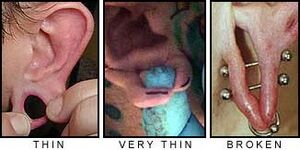Piercing Technique and Piercing Thinning: Difference between pages
(Page conversion via llm-mediawiki-rev -jwm) |
(Page conversion via llm-mediawiki-rev -jwm) |
||
| Line 1: | Line 1: | ||
[[File:Piercing_Thinning-1.jpg|thumb|right|Piercing Thinning-1]] | |||
When a piercing—most typically a [[Earlobe Stretching|stretched earlobe piercing]], [[Nipple piercing|nipple piercing]], or [[Frenum piercing|frenum piercing]]—is overstretched, the tissue surrounding the piercing may not all "grow" evenly. Rather than expanding to meet the stretching, it may simply thin out. | |||
This is exacerbated by "weak spots". For example, if there is one weak point in the surrounding tissue, that tissue will tend to take all the stretching, often by thinning. Outside of overstretching alone, weak spots or '''piercing thinning''' are most often caused by one of the following: | |||
* Weight: weights are NOT a good way to stretch. Weights put far more pressure on the bottom of a piercing than the top, and tend to wear away and thin out this tissue. Do not stretch using weights. Stretching should be accomplished by gradual increase in size of the jewelry. | |||
* Poor placement: if a lobe piercing is placed close to the edge of the lobe, it has a natural weak point. When stretching, the forces will focus on that point, eventually breaking it. | |||
== See Also== | If you notice your piercing thinning out, you are probably out of luck on further stretching on this piercing. You may be able to surgically correct this problem, or find non-stretching methods of increasing the piercing's size (such as [[Scalpelled Lobe|ear scalpelling]]). | ||
* [[ | |||
== See Also == | |||
* [[Rejection]] | |||
* [[Migration]] | |||
== Entries related to this risk == | |||
* [[Earlobe Stretching]] | |||
Latest revision as of 09:45, 17 September 2023
When a piercing—most typically a stretched earlobe piercing, nipple piercing, or frenum piercing—is overstretched, the tissue surrounding the piercing may not all "grow" evenly. Rather than expanding to meet the stretching, it may simply thin out.
This is exacerbated by "weak spots". For example, if there is one weak point in the surrounding tissue, that tissue will tend to take all the stretching, often by thinning. Outside of overstretching alone, weak spots or piercing thinning are most often caused by one of the following:
- Weight: weights are NOT a good way to stretch. Weights put far more pressure on the bottom of a piercing than the top, and tend to wear away and thin out this tissue. Do not stretch using weights. Stretching should be accomplished by gradual increase in size of the jewelry.
- Poor placement: if a lobe piercing is placed close to the edge of the lobe, it has a natural weak point. When stretching, the forces will focus on that point, eventually breaking it.
If you notice your piercing thinning out, you are probably out of luck on further stretching on this piercing. You may be able to surgically correct this problem, or find non-stretching methods of increasing the piercing's size (such as ear scalpelling).
